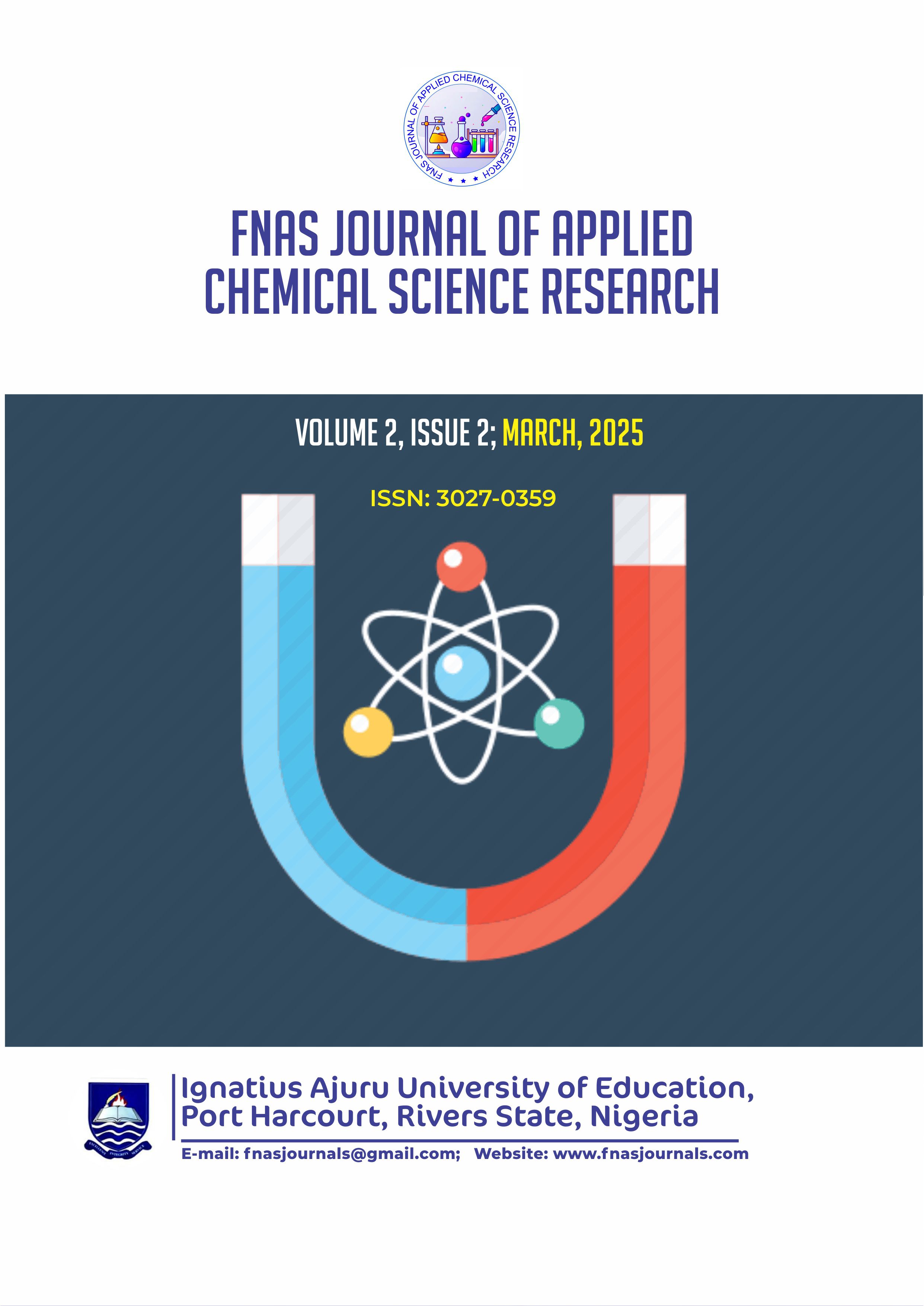Assessment of Pesticide Residue Levels in Beans, Maize, and Rice from Rivers State, Nigeria
Keywords:
Pesticide, Beans, Maize, Rice, Rivers StateAbstract
Pesticide residues in grains are a significant public health concern due to their potential toxic effects. This study conducted a comparative analysis of pesticide residue concentrations in three common grains (beans, maize, and rice) sourced from markets within Port Harcourt Metropolis and farms in nearby rural areas. Using Gas Chromatography-Mass Spectrometry (GC-MS), A total of 22 pesticide residues were detected which include; aluminium phosphate, atrazine, tetra chloro iso-phthalonitrile, β-hexachloro cyclo hexane, Quintozen, Benzene (Hexa Chloro), α-Lindane, Perthane, Captan, Diazinone, Phenthoate, Malathion, Dichlorodiphenyl Dichloro Ethylene (DDE), Aldrin, Dieldrin, Dichlorodiphenyltrichloro Ethane (DDT), Ethiom, Methaxychlor, Primiphos Methyl, α-Endosulfan, Cis-Chlordane and Endosulfan Sulfate.The observed Pesticides mean concentrations for farm grains ranges From 0.04 mg/kg to 0.23 mg/kg for Beans, 0.04 mg/kg to 0.29 mg/kg for Maize,and 0.08 mg/kg to 0.37 mg/kg for Rice. The mean concentrations for creek road market grains ranged from 0.04 mg/kg to 2.77 mg/kg for Beans, 0.04 mg/kg to 0.53 mg/kg For Maize while residue in Rice ranges from 0.05 mg/kg to 0.72 mg/kg. The mean concentrations in mile one market grains ranges from 0.04 mg/kg to 0.83 mg/kg for beans, 0.05 mg/kg to 0.48 mg/kg for maize and 0.04 mg/kg to 3.65 mg/kg for rice. While the The observed Pesticides mean concentrations for oil mill market grains ranges From 0.04 mg/kg to 0.83 mg/kg for beans, 0.05 mg/kg to 0.48 mg/kg for maize and 0.04 mg/kg to 3.65 mg/kg for rice. This indicated significantly higher pesticide residue levels in market-sourced grains compared to farm-fresh samples. Comparing the detected residue levels with maximum residue limit (MRL) for standard given by WHO/FAO. The mean level for most pesticides exceeded FAO/WHO permissible limits, but market-sourced are comparably high than the farm-fresh grains. The Statistical analysis using ANOVA at 5% significant level, statically showed a degree of significant difference between the farm-sourced grains and the market grains likely due to higher variability introduced by post-harvest handling and storage practices.Analyzing contamination factors (CF) and pollution load index (PLI),Results revealed considerable contamination, particularly in rice, which exhibited the highest levels of residues, particularly for DDE (1.62 mg/kg) and Malathion (1.19 mg/kg).The contamination factor (CF) values also indicated that Quintozen and Benzene (Hexa Chloro) had the highest contamination in beans and rice with high contamination factors recorded for Quintozen (83 in Oil Mill beans) and Benzene (Hexa Chloro) (24 in Mile One beans and 60 in Oil Mill rice). The PLI values ranged from 2.32 to 4.8, indicated moderate to severe pollution across all grains with rice showing the highest pollution burden. The elevated residue levels in markets were attributed to post-harvest pesticides treatment and improper storage practices. The findings underscore the urgent need for stricter pesticide regulations, routine residue monitoring, and the promotion of sustainable agricultural practices to ensure food safety.
References
Adeola, S. A., & Olufemi, O. B. (2020). Pesticide usage and its impact on agricultural products in Nigeria. Journal of Agricultural Science and Technology, 12(4), 123-134.
Akan, J. C., Abdulrahman, F. I., Sodipo, O. A., & Chiroma, Y. A. (2013). Distribution of pesticides in soils and water from the River Benue and its tributaries in Northern Nigeria. International Journal of Environmental Monitoring and Analysis, 1(4), 70-77.
Garcia, F. P., Ascencio, S. Y. C., Oyarzun, J. C. G., Hernandez, A. C., & Alavarado, P. V. (2012). Pesticides Classification, uses, and toxicity: Measures of exposure and genotoxic risks. International Journal of Environmental Science and Toxicology Research, 1(7), 279-293..
Okeke, C. F., Eze, J. O., & Olatunji, A. (2021). Assessing pesticide residues in Nigerian grains: Implications for consumer health. African Journal of Food Science, 15(1), 24-32.
Okeke, J. U., & Adebayo, T. A. (2021). Storage practices and pesticide contamination in Nigerian grains: A case study of cowpea. International Journal of Food Science, 10(2), 56-63. Okrikata, E., Agere, H., Malu, S. P., Olusesan, A. I., & Ahmed, M. (2022). Determination and Health risk assessment of pesticide residues in watermelon (citrullus lanatus) fruit Samples in wukari, Nigeria. The Bioscientist Journal, 10(1), 41-54.
World Health Organization, (2019). Health risks associated with pesticide residues in food. Geneva: WHO Press.


